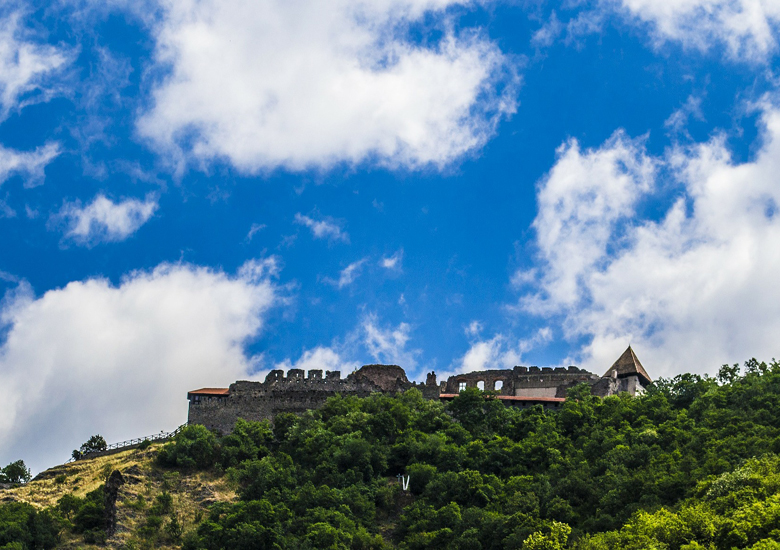Visegrád is a small castle town in Pest County, Hungary.
- Upper Castle : After the Mongol invasion, King Bela IV of Hungary and his wife had a new fortification system constructed in the 1240-50s near the one destroyed earlier. The first part of the new system was the Upper Castle on top of a high hill. The castle was laid out on a triangular ground plan and had three towers at its corners. In the 14th century, at the time of the Angevin kings of Hungary, the castle became a royal residence and was enlarged with a new curtain wall and palace buildings.
Around 1400 King Sigismund had a third curtain wall constructed and enlarged the palace buildings. At the end of the 15th century, King Matthias Corvinus had the interior renovated. The Upper Castle also served for the safekeeping of the Hungarian royal insignia between the 14th century and 1526. In 1544 Visegrad was occupied by the Ottoman Empire, and, apart from a short period in 1595-1605, it remained in Turkish hands until 1685. The castle was seriously damaged by the Turks and was never used afterwards.
- Lower Castle : The Lower Castle is the part of the fortification system that connects the Upper Castle with the Danube. In its centre rises the Solomon Tower, a large, hexagonal residential tower dating from the 13th century. In the 14th century, new curtain walls were built around the tower. During a Turkish raid in 1544, the southern part of the tower collapsed. Its renovation began only in the 1870s and was finished in the 1960s. At present, the Tower houses exhibitions installed by the King Matthias Museum (Matyas Kiraly Muzeum) of Visegrad. The exhibitions present the reconstructed Gothic fountains from the Royal Palace, Renaissance sculpture in Visegrad, and the history of Visegrad.
- Royal Palace : The first royal house on this site was built by King Charles I of Hungary after 1325. In the second half of the 14th century, this was enlarged into a palace by his son, King Louis I of Hungary. In the last third of the 14th century, King Louis and his successor Sigismund of Luxembourg had the majority of the earlier buildings dismantled and created a new, sumptuous palace complex, the extensive ruins of which are still visible today. The palace complex was laid out on a square ground plan measuring 123 x 123 m. A garden adjoined to it from the north and a Franciscan friary, founded by King Sigismund in 1424, from the south. In the time of Louis I and Sigismund, the palace was the official residence of the kings of Hungary until about 1405-08.
Between 1477 and 1484 Matthias Corvinus had the palace complex reconstructed in late Gothic style. The Italian Renaissance architectural style was used for decoration, the first time the style appeared in Europe outside Italy. After the Ottoman Turks’ siege in 1544, the palace fell into ruins. By the 18th century it was completely covered by earth. Its excavation began in 1934 and continues today. The reconstructed royal residence building is open to the public and houses exhibitions on the history of the palace and reconstructed historical interiors
- Sibrik Hill : The ruins of this military camp can be seen outside Visegrad, to the north, on a hill that overlooks the Danube. The camp has a triangular ground plan. It was built in the first half of the 4th century as one of the important fortifications along the limes, the frontier of the Roman Empire. Its praetorium (the commander’s building) was constructed at the end of the 4th century. In the early 5th century, the Roman army abandoned the military camp. In the 10th and 11th centuries, the fortification, rebuilt as a castle, became a regional centre of the recently formed Hungarian state. “Visegrad” appears for the first time as the name of this regional centre (1009). The fortification was finally destroyed in 1242 by the Mongol invasion of Europe. The castle is now open to the public to visit
Access : Coordinates: Location: City of Visegrad is 46 km north of Budapest (GPS N 47°46′ 47.18″ E 18°58’57.94″) and about. 15 km west of the city of Vac
By train : 1 Nagymaros–Visegrad Railway Station (Nagymaros–Visegrad Vasutallomas) (the station will be cca. 300m away from the Nagymaros pier, on the opposite side of the river so you need to take a 5-minute ferry ride across; ferries are scheduled to train arrivals). From Budapest Nyugati railway station (cca. 40-60 minutes, runs every 60 minutes) all stop at Vac. Train timetable.
By bus : Take a direct bus at Budapest, Arpad hid bus station to Visegrad (cca. 80 minutes, runs every 20-60 minutes). Also regularly buses to Esztergom. Volan bus timetable
By boat : 2 Visegrad Boat Station (Visegradi hajoallomas), Visegrad, Rev utca (Visegrad center) +36 26 398-296. A more expensive (but much more picturesque) way to get from Budapest (Vigado ter and Batthyany ter) to Visegrad is an excursion boat toward Esztergom stop here (May to Aug, daily once except Monday, + Sept only Sundays, ticket OW/RW, HUF2000/3000, 2014) via Vac and an other one operating (Jul to Aug only Sat, Sun, +May 31, Jun 1, Sept 27 three and half hours, ticket OW/RW, HUF2000/3000, 2014) via Szentendre, Leanyfalu, Tahitotfalu. Also a hydrofoil service run from Budapest, Vigado ter by Mahart (weekly twice, only between May and September, one hour). A hydrofoil ticket (OW/RW, HUF, 2014) to Budapest 4000/6000, Esztergom 2500/4000
3 Nagymaros ferry pier (Nagymaros-Visegrad REV), Magyar utca, +36 26 398344 (ferry info). Boats to Visegrad (at 06.30, and between 08:00 and 21:00 hourly, cca. 15min). Schedules are indicative due to water, weather and other reasons.

